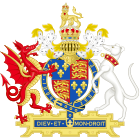Buggery Act 1533

|
|
| Long title | An Acte for the punishment of the vice of Buggerie |
|---|---|
| Citation | 25 Hen. 8 c. 6 |
| Other legislation | |
| Repealed by | Offences against the Person Act 1828 (9 Geo. 4 c. 31) |
|
Status: Repealed
|
|
The Buggery Act 1533, formally An Acte for the punishment of the vice of Buggerie (25 Hen. 8 c. 6), was an Act of the Parliament of England that was passed during the reign of Henry VIII. It was the country's first civil sodomy law, such offences having previously been dealt with by the ecclesiastical courts.
The Act defined buggery as an unnatural sexual act against the will of God and man. This was later defined by the courts to include only anal penetration and bestiality. The Act remained in force until it was repealed and replaced by the Offences against the Person Act 1828, and buggery would remain a capital offence until 1861.
The Act was piloted through Parliament by Henry VIII's minister Thomas Cromwell and punished "the detestable and abominable Vice of Buggery committed with Mankind or Beast". "Buggery" was not further defined in the law. According to the Act:
the offenders being hereof convicted by verdict confession or outlawry shall suffer such pains of death and losses and penalties of their good chattels debts lands tenements and hereditaments as felons do according to the Common Laws of this Realm. And that no person offending in any such offence shall be admitted to his Clergy ...
This meant that a convicted sodomite’s possessions could be confiscated by the government, rather than going to their next of kin, and that even priests and monks could be executed for the offence—even though they could not be executed for murder. Henry later used the law to execute monks and nuns (thanks to information his spies had gathered) and take their monastery lands—the same tactics had been used 200 years before by Philip IV of France against the Knights Templar. Henry may have had this in mind when he drafted the Act.
In July 1540 Walter Hungerford, 1st Baron Hungerford of Heytesbury was charged with treason for harbouring a known member of the Pilgrimage of Grace movement. Although he had been married three times, and had four children, he was also accused of buggery. Hungerford was beheaded at Tower Hill (as he was not hanged it suggests the accusations of buggery were for purposes of humiliation), on 28 July 1540, the same day as Thomas Cromwell.
...
Wikipedia
